Mechanical Behavior of Crimping Composite Post Insulator: Experimental and Simulation Study
Abstract
:1. Introduction
2. Materials and Methods
2.1. Simplified Mechanical Model
2.2. Finite Element Model
2.3. Experimental Verification of Statics
2.4. Experimental Verification of Vibration Characteristics
3. Results and Discussion
4. Conclusions
- The MPC local constraint modeling method of ANSYS software is used to simulate the flange crimping process of composite post insulator. The difference between the simulation and test results is less than 5%. The simulation analysis method can be applied to the finite element simplified modeling of the post insulator in the flexible DC converter valve;
- When the height of the insulator stiffener (non-pressing area) is constant, the influence of flange height and flange thickness on the horizontal stiffness of the insulator can be ignored. When the flange height and thickness change, the natural frequency of the insulator varies within 3%, which shows that the structural parameters have little effect on it. On the other hand, when the flange height changes and the thickness is fixed at 10 mm, the maximum horizontal displacement of the single insulator changes the most. The maximum horizontal displacement decreases from 23.6 mm to 23 mm with the increase in flange height, and the decrease is 2.5%. When the flange thickness changes and the height is fixed at 205 mm, the maximum horizontal displacement of a single insulator changes the most. The maximum horizontal displacement decreases from 23 mm to 21.8 mm with the increase in height, and the decrease is 5.2%. These changes are about 5%, so the impact is negligible;
- When the height of the insulator stiffener (non-pressing area) is constant, the change in flange thickness significantly affects the insulator’s bending performance. The thicker the crimped composite post insulator flange is, the smaller the maximum bending stress, and the maximum decrease is 54.4%. That is, the increase in flange thickness can significantly increase the bending resistance of the insulator;
- In the production of the crimping insulator, the height of the flange is reduced as much as possible under the condition of process permission. The increase in flange height not only increases the cost but also reduces the dry arc distance of the insulator. More importantly, the influence of the flange height on the bending strength of the insulator can be ignored.
Author Contributions
Funding
Data Availability Statement
Conflicts of Interest
References
- Ang, A.H.-S.; Pires, J.A.; Villaverde, R. A Model for the Seismic Reliability Assessment of Electric Power Transmission Systems. Reliab. Eng. Syst. Saf. 1996, 51, 7–22. [Google Scholar] [CrossRef]
- Arrillaga, J.; Watson, N.R.; Liu, Y.H. Flexible Power Transmission: The Hvdc Options; John Wiley & Sons: New York, NY, USA, 2007. [Google Scholar]
- Park, R.; Billings, I.J.; Clifton, G.C.; Cousins, J.; Filiatrault, A.; Jennings, D.N.; Jones, L.C.P.; Perrin, N.D.; Rooney, S.L.; Sinclair, J.; et al. The Hyogo-Ken Nanbu Earthquake (the Great Hanshin Earthquake) of 17 January 1995: Report of the Nznsee Reconnaissance Team. Bull. Bull. N. Z. Soc. Earthq. Engineering 1995, 28, 1–98. [Google Scholar]
- Sokolov, V.; Wenzel, F. On the Modeling of Ground-Motion Field for Assessment of Multiple-Location Hazard, Damage, and Loss: Example of Estimation of Electric Network Performance During Scenario Earthquake. Nat. Hazards 2014, 74, 1555–1575. [Google Scholar] [CrossRef]
- Christensen, R.M. Mechanics of Composite Materials; Courier Corporation: North Chelmsford, MA, USA, 2012. [Google Scholar]
- Epackachi, S.; Dolatshahi, K.M.; Oliveto, N.D.; Reinhorn, A.M. Mechanical Behavior of Electrical Hollow Composite Post Insulators: Experimental and Analytical Study. Eng. Struct. 2015, 93, 129–141. [Google Scholar] [CrossRef]
- Xidong, L.; Shaowu, W.; Ju, F.; Zhicheng, G. Development of Composite Insulators in China. IEEE Trans. Dielectr. Electr. Insul. 1999, 6, 586–594. [Google Scholar] [CrossRef]
- Huang, H.; Xu, Y.; Li, H.; Zhang, Z.; Li, Y.; Zhang, H.; Cheng, J.; Yi, B.; Wang, Z.; Zhang, G. Optimization and Comparison of Specific ON-Resistance for Superjunction MOSFETs Considering Three-Dimensional and Insulator-Pillar Concepts. IEEE Trans. Electron Devices 2022, 69, 1162–1168. [Google Scholar] [CrossRef]
- Mohammadi, R.K.; Akrami, V.; Nikfar, F. Dynamic Properties of Substation Support Structures. J. Constr. Steel Res. 2012, 78, 173–182. [Google Scholar] [CrossRef]
- Moustafa, M.A.; Mosalam, K.M. Structural Performance of Porcelain and Polymer Post Insulators in High Voltage Electrical Switches. J. Perform. Constr. Facil. 2016, 30, 04016002. [Google Scholar] [CrossRef]
- Wen, B.; Niu, D.T. Seismic Response Analysis of Substation Involving Interaction of Main Structure-Electrical Equipments. Adv. Mater. Res. 2011, 163-167, 4022–4026. [Google Scholar] [CrossRef]
- Rowland, S.M.; Robertson, J.; Xiong, Y.; Day, R.J. Electrical and Material Characterization of Field-Aged 400 Kv Silicone Rubber Composite Insulators. IEEE Trans. Dielectr. Electr. Insul. 2010, 17, 375–383. [Google Scholar] [CrossRef]
- Tedesco, J.; McDougal, W.G.; Ross, C.A. Structural Dynamics; Pearson Education: London, UK, 2000. [Google Scholar]
- Cimellaro, G.P.; Reinhorn, A.M.; Schiff, A. Evaluation of Hollow Core Composite Insulators. In Proceedings of the TCLEE 2009: Lifeline Earthquake Engineering in a Multihazard Environment, Oakland, CA, USA, 28 June–1 July 2009; pp. 1–12. [Google Scholar]
- Cimellaro, G.P.; Roh, H.; Fahad, M.; Reinhorn, A.M.; Schiff, A. Modeling Combined Friction-Viscous Damping in Response of Hollow Core Composite Insulators. In Proceedings of the Structures Congress 2010, Orlando, FL, USA, 12–15 May 2010; pp. 2736–2747. [Google Scholar]
- Hong, R.; Bing, L.; Li, X.; Zongyuan, C.; Li, L. Development of ± 800kv Uhvdc Transmission Technology in China. In Proceedings of the 2008 International Conference on High Voltage Engineering and Application, Chongqing, China, 9–13 November 2008. [Google Scholar]
- Liang, X.; Bao, W.; Gao, Y. Decay-Like Fracture Mechanism of Silicone Rubber Composite Insulator. IEEE Trans. Dielectr. Electr. Insul. 2018, 25, 110–119. [Google Scholar] [CrossRef]
- Faliang, H.E. Development of Crimped Composite Post Insulator with Large Diameter Core Rod. Insul. Surge Arresters 2020, 2, 222–228. [Google Scholar]
- Safonov, A.; Gusev, M.; Saratov, A.; Konstantinov, A.; Sergeichev, I.; Konev, S.; Gusev, S.; Akhatov, I. Modeling of Cracking During Pultrusion of Large-Size Profiles. Compos. Struct. 2019, 235, 111801. [Google Scholar] [CrossRef]
- Volk, M.; Wong, J.; Arreguin, S.; Ermanni, P. Pultrusion of Large Thermoplastic Composite Profiles up to 40 Mm from Glass-Fibre/Pet Commingled Yarns. Compos. Part B Eng. 2021, 227, 109339. [Google Scholar] [CrossRef]
- Zhang, J.; Jiang, L.; Huang, Z.; Xu, X.; Wu, P.; Lei, H. Seismic Analysis under Sl-1 of New Structure Support Frame for Iter Pf Converter System. IEEE Trans. Plasma Sci. 2022, 50, 4355–4360. [Google Scholar] [CrossRef]
- Shiling, Z. Research on Operation Characteristics of Uhv Converter Valve Hall Based on Intelligent Image Processing and 3d Modeling Technology. J. Phys. Conf. Ser. 2021, 1871, 012135. [Google Scholar] [CrossRef]
- Yang, Z.; Xie, Q.; Zhou, Y.; Mosalam, K.M. Seismic Performance and Restraint System of Suspended 800 Kv Thyristor Valve. Eng. Struct. 2018, 169, 179–187. [Google Scholar] [CrossRef]
- Hasegawa, T.; Yamaji, K.; Irokawa, H.; Shirahama, H.; Tanaka, C.; Akabane, K. Development of a Thyristor Valve for Next Generation 500 Kv Hvdc Transmission Systems. IEEE Trans. Power Deliv. 1996, 11, 1783–1788. [Google Scholar] [CrossRef]
- Liang, H.; Qiang, X. System Vulnerability Analysis Simulation Model for Substation Subjected to Earthquakes. IEEE Trans. Power Deliv. 2021, 37, 2684–2692. [Google Scholar] [CrossRef]
- He, C.; Jiang, L.; Jiang, L. Seismic Failure Risk Assessment of Post Electrical Equipment on Supporting Structures. IEEE Trans. Power Deliv. 2023. [Google Scholar] [CrossRef]
- Wang, Z.D.; Zhang, M.; Yang, J.; Fang, S.Z.; Wang, W. Study on Bending Stiffness of Solid Post Composite Insulator. In Proceedings of the 2020 IEEE International Conference on High Voltage Engineering and Application (ICHVE), Beijing, China, 6–10 September 2020. [Google Scholar]
- Jawdhari, A.; Fam, A.; Kadhim, M.M. Thermal Bowing of Reinforced Concrete Sandwich Panels Using Time-Domain Coupled-Field Finite Element Analysis. Eng. Struct. 2021, 252, 113592. [Google Scholar] [CrossRef]
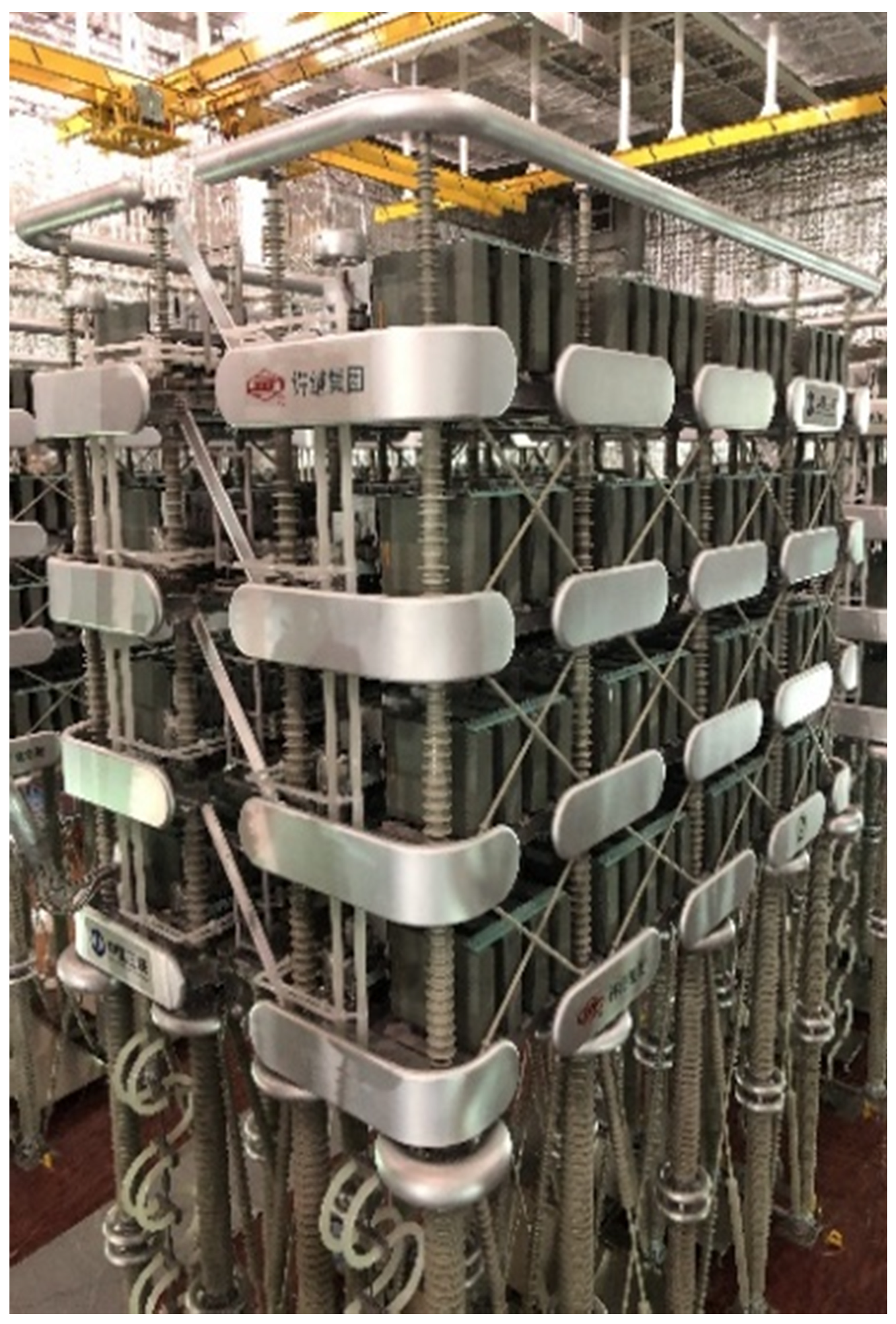
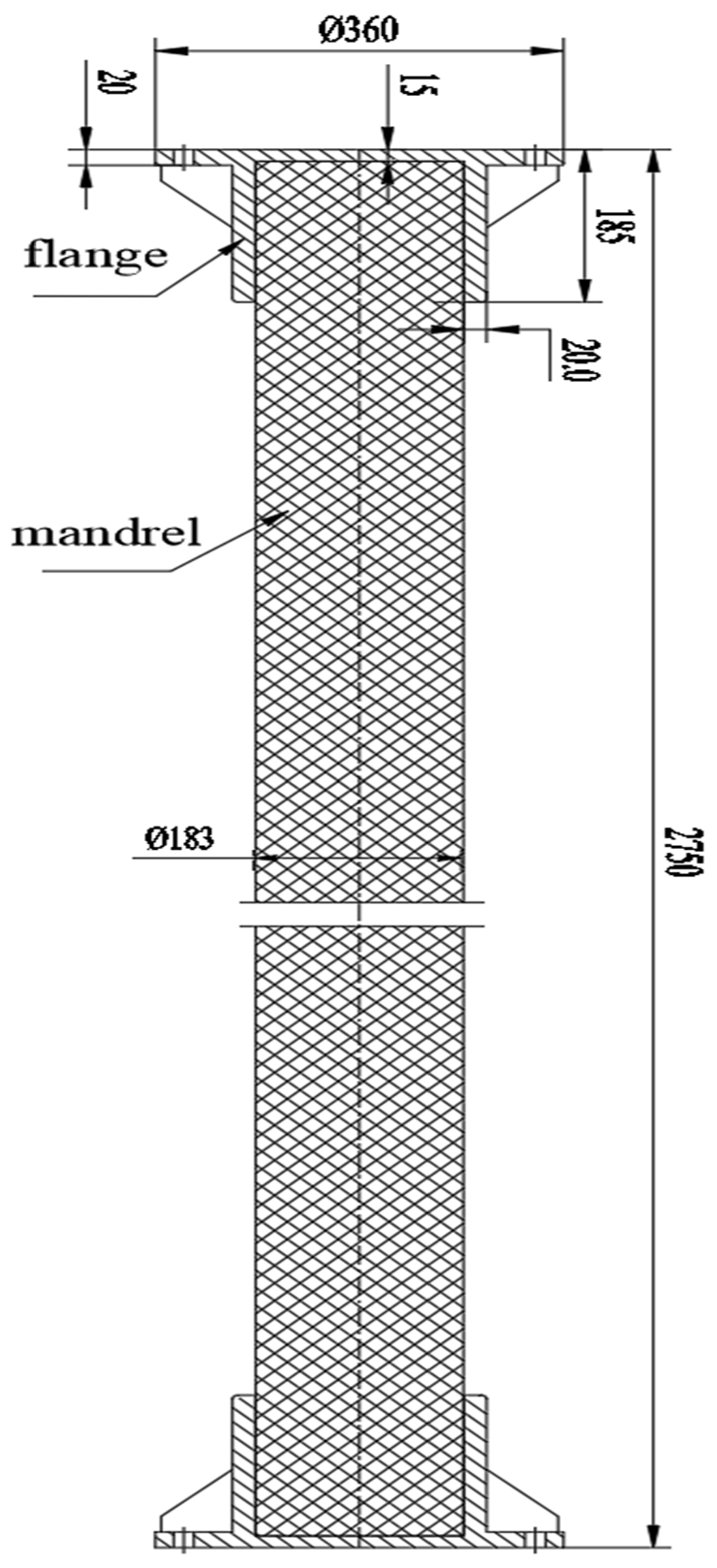



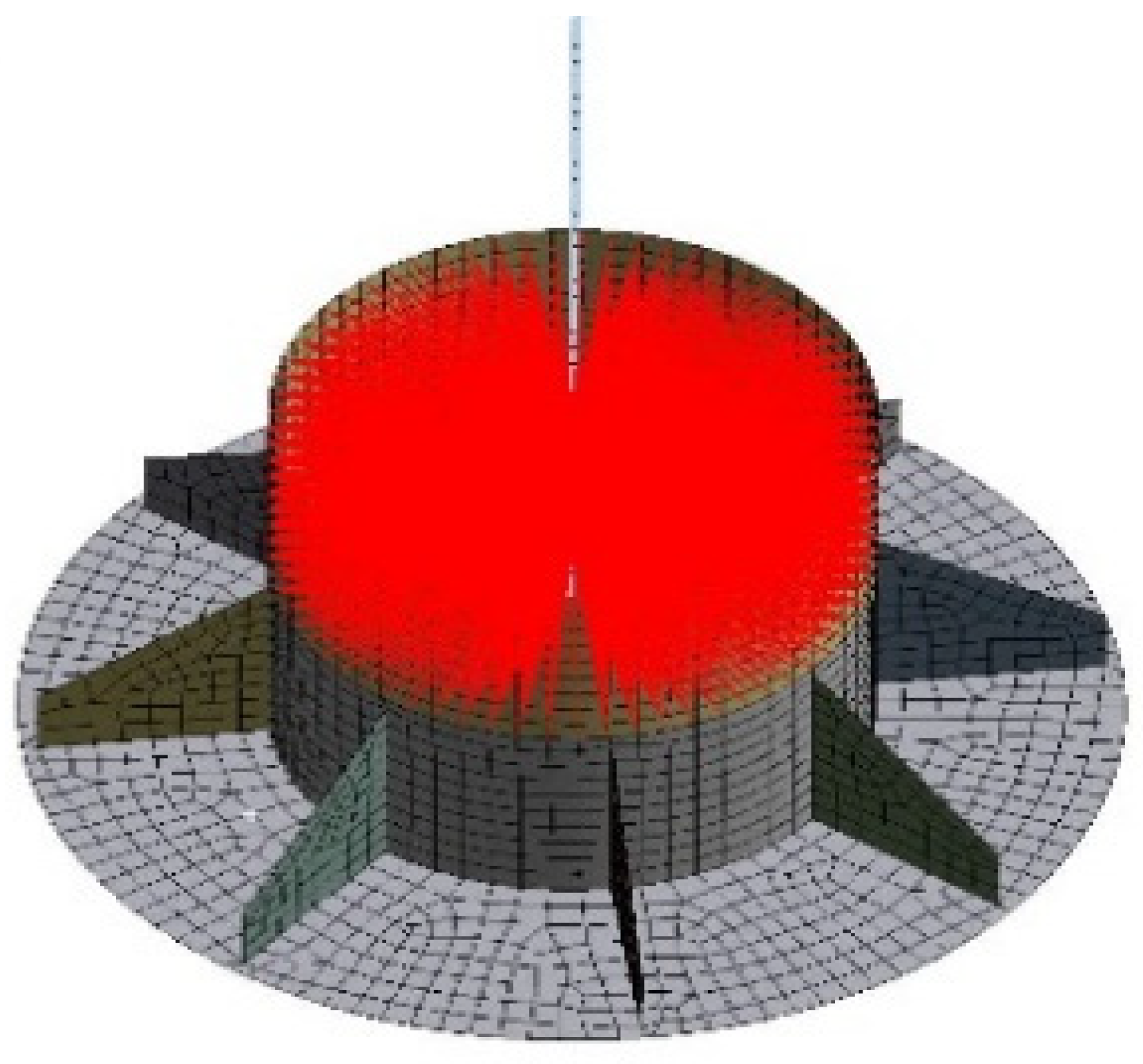
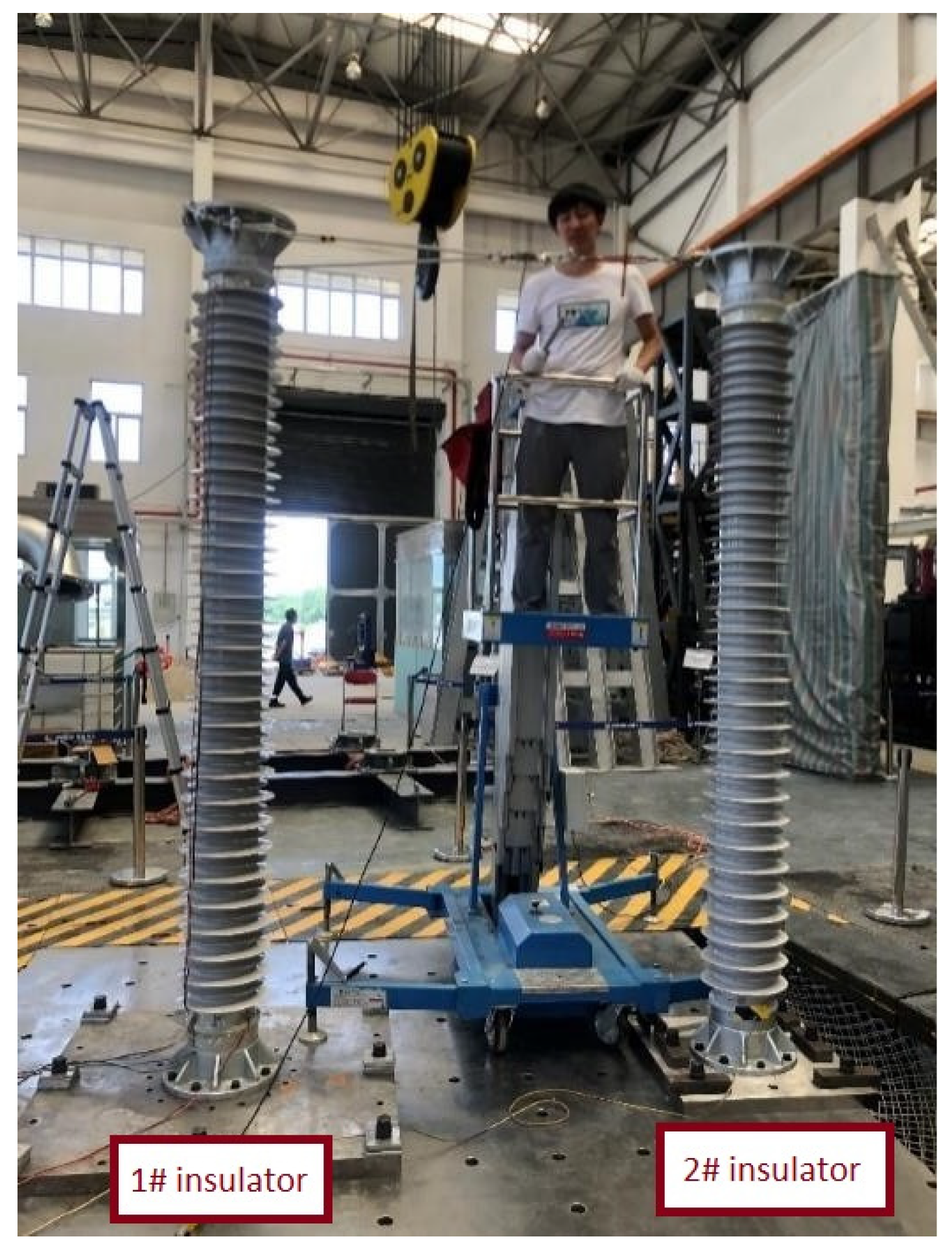
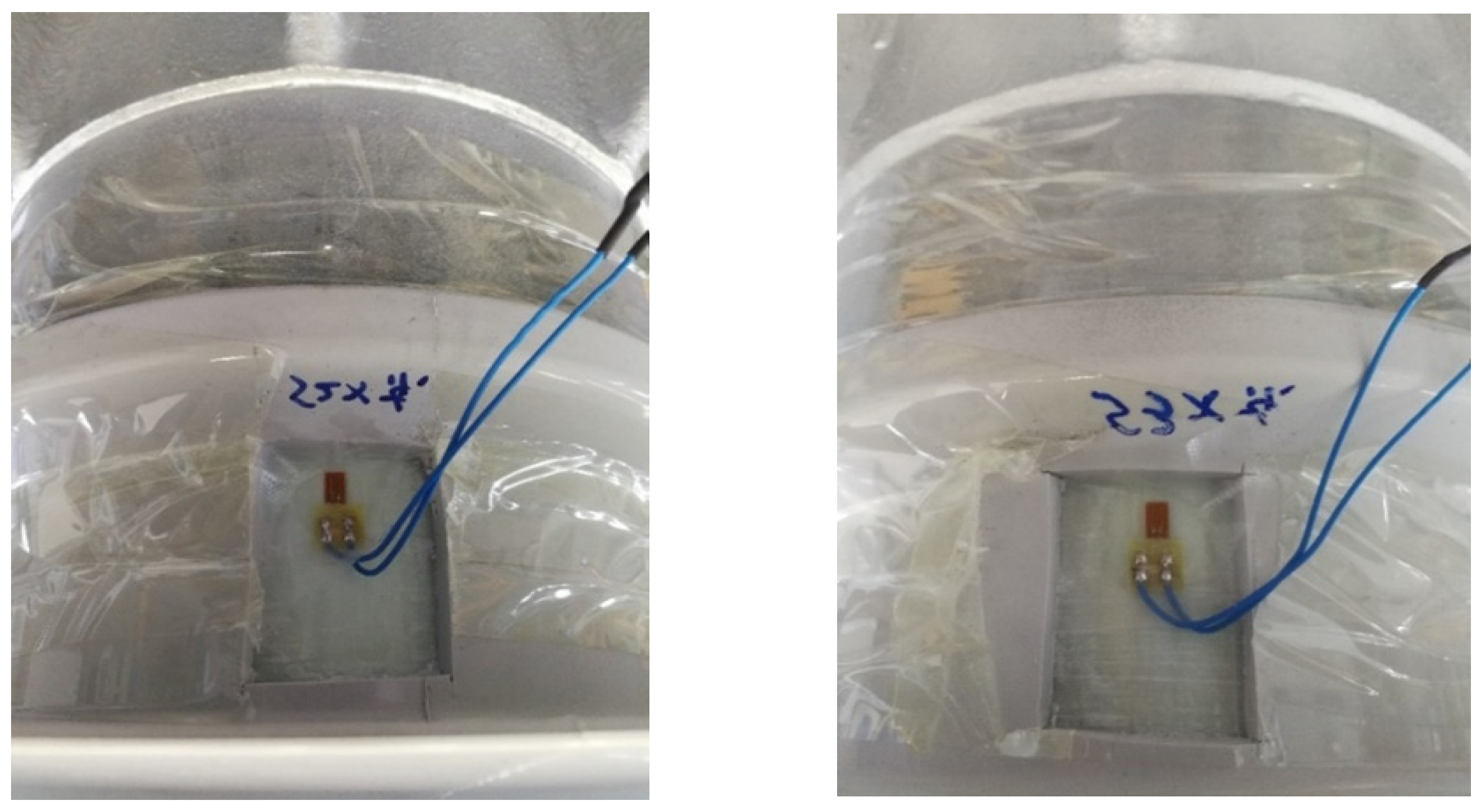
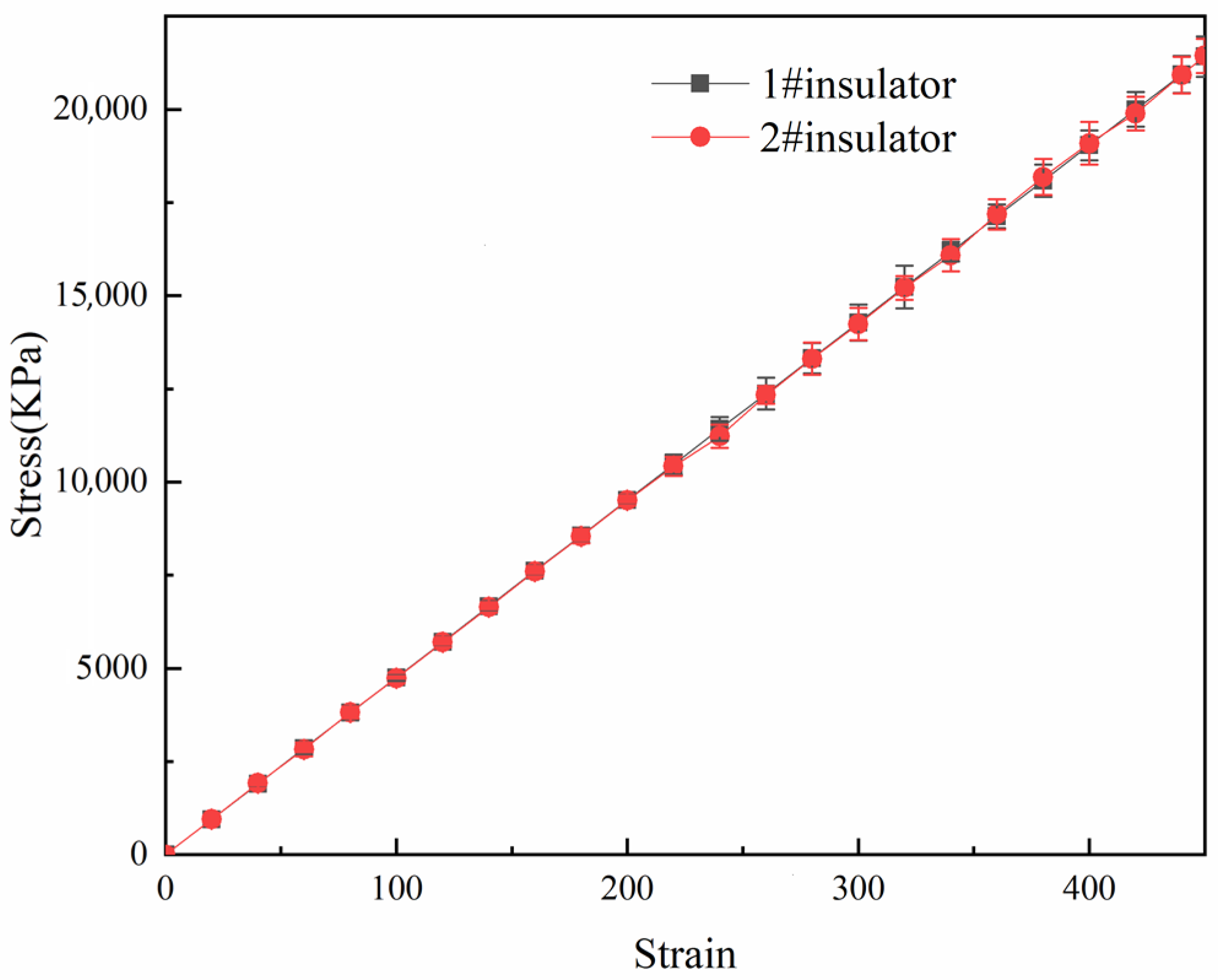

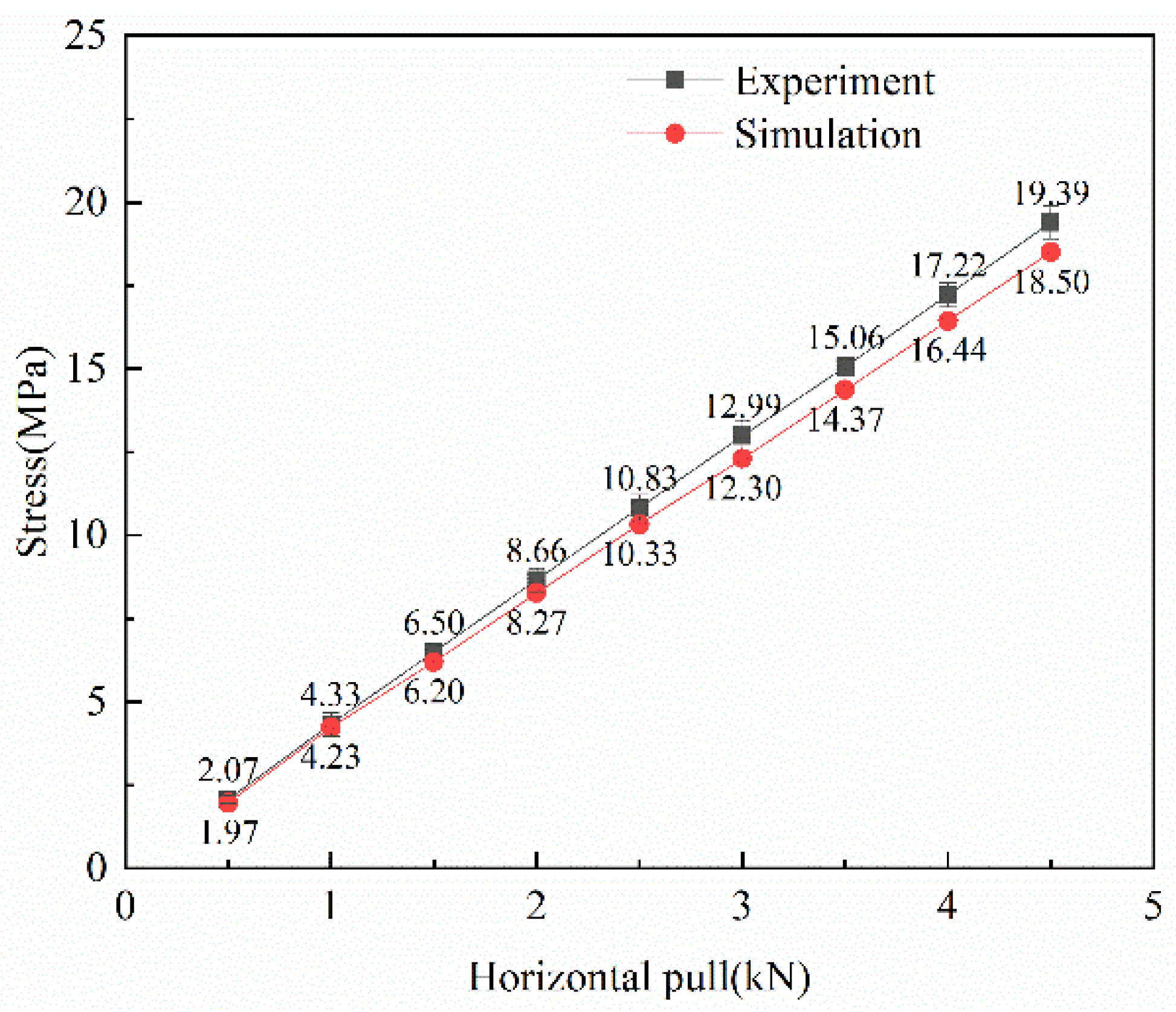
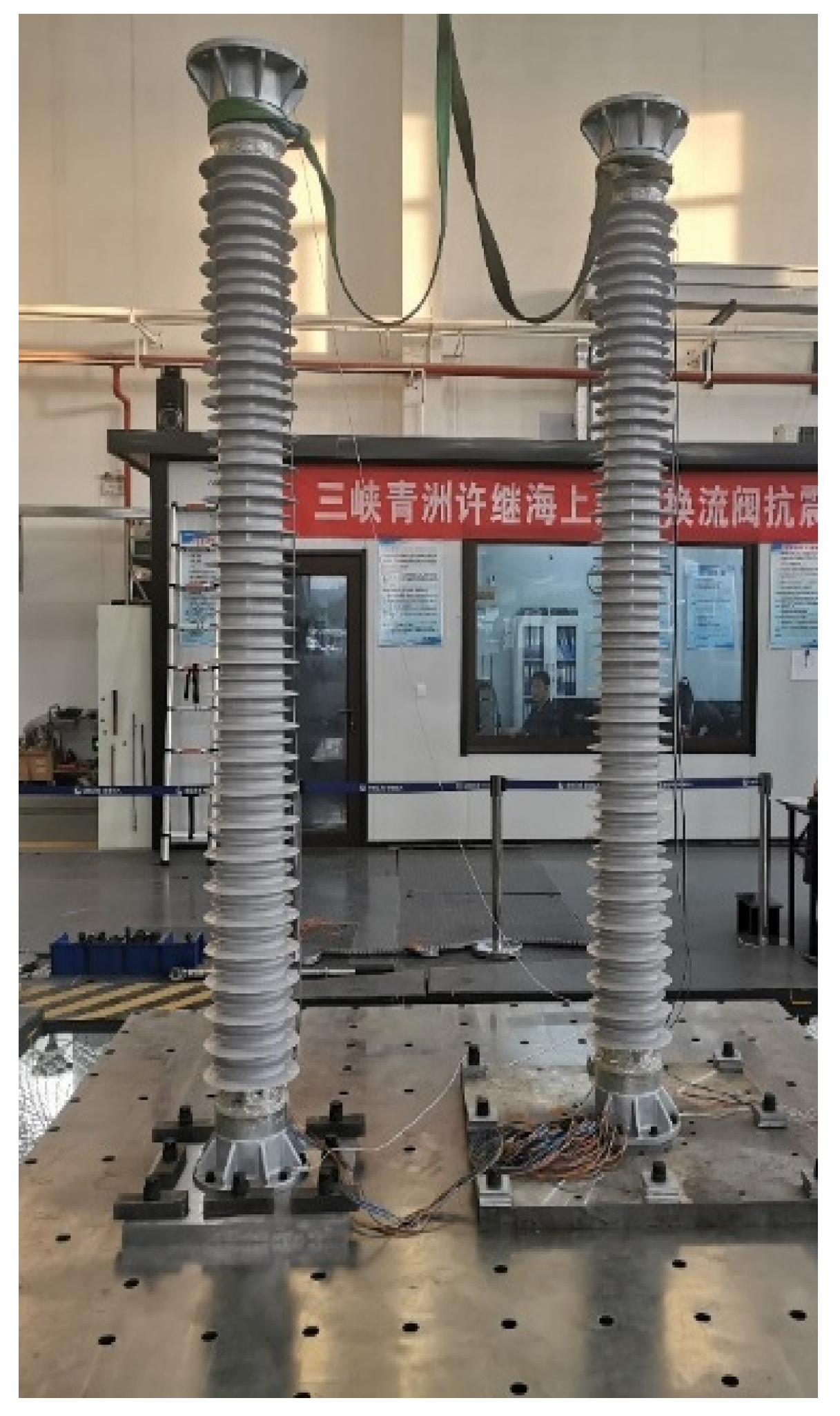
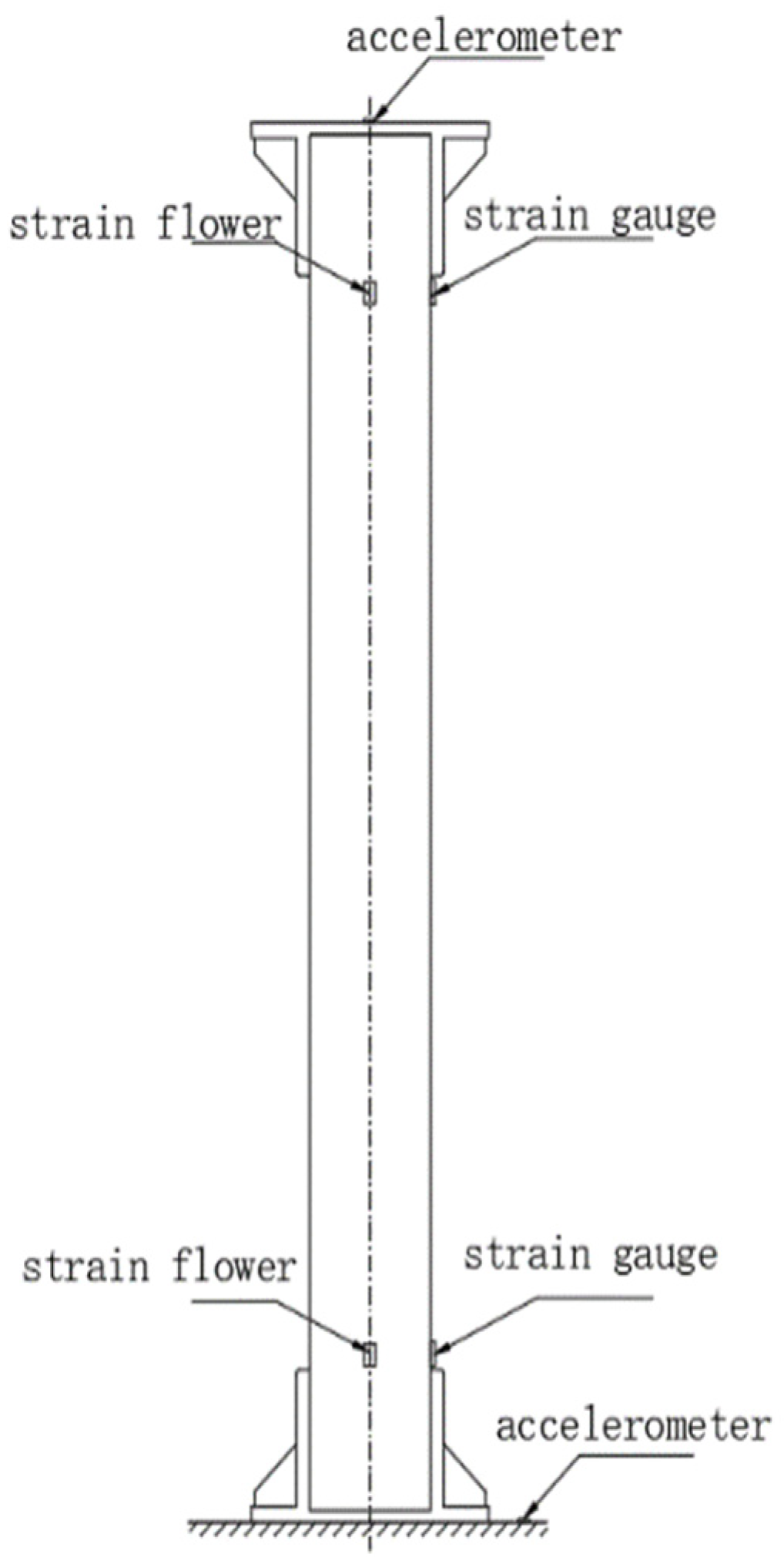
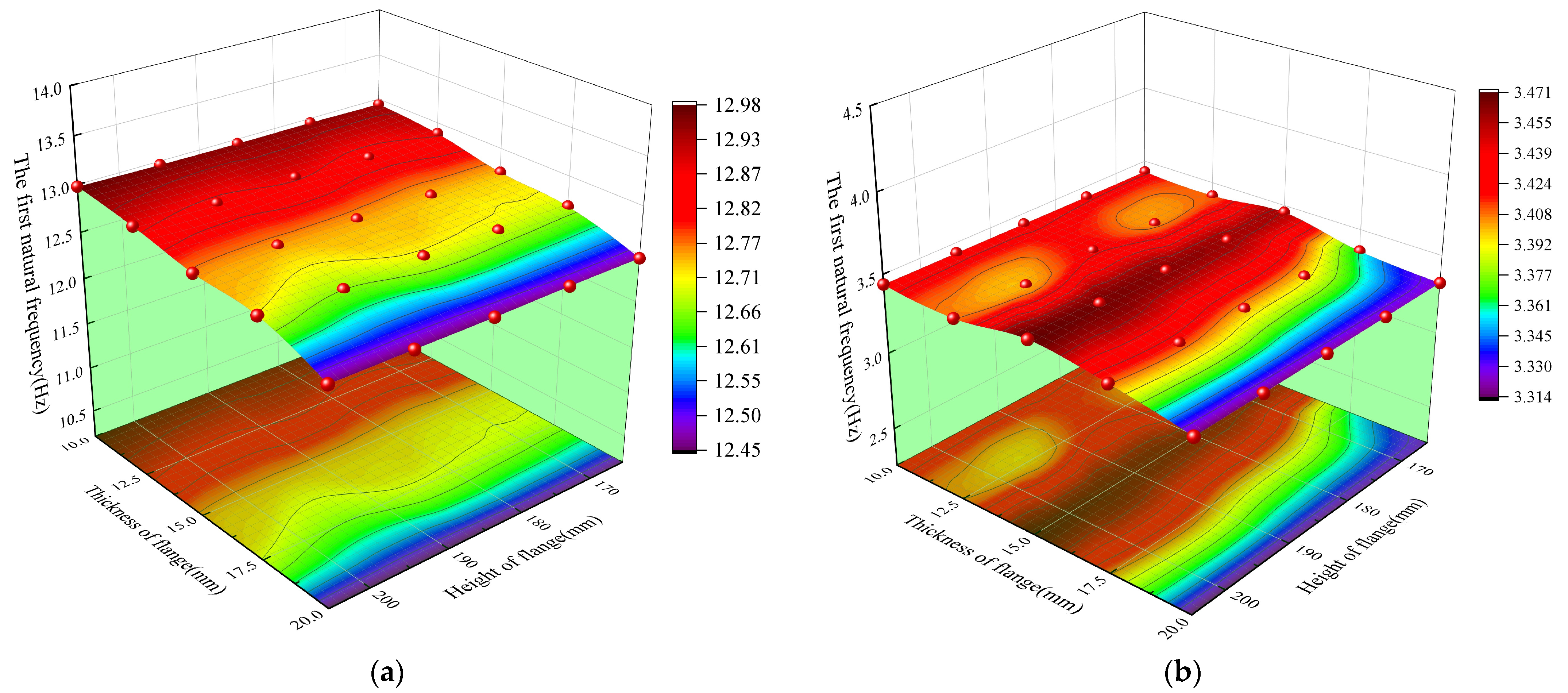
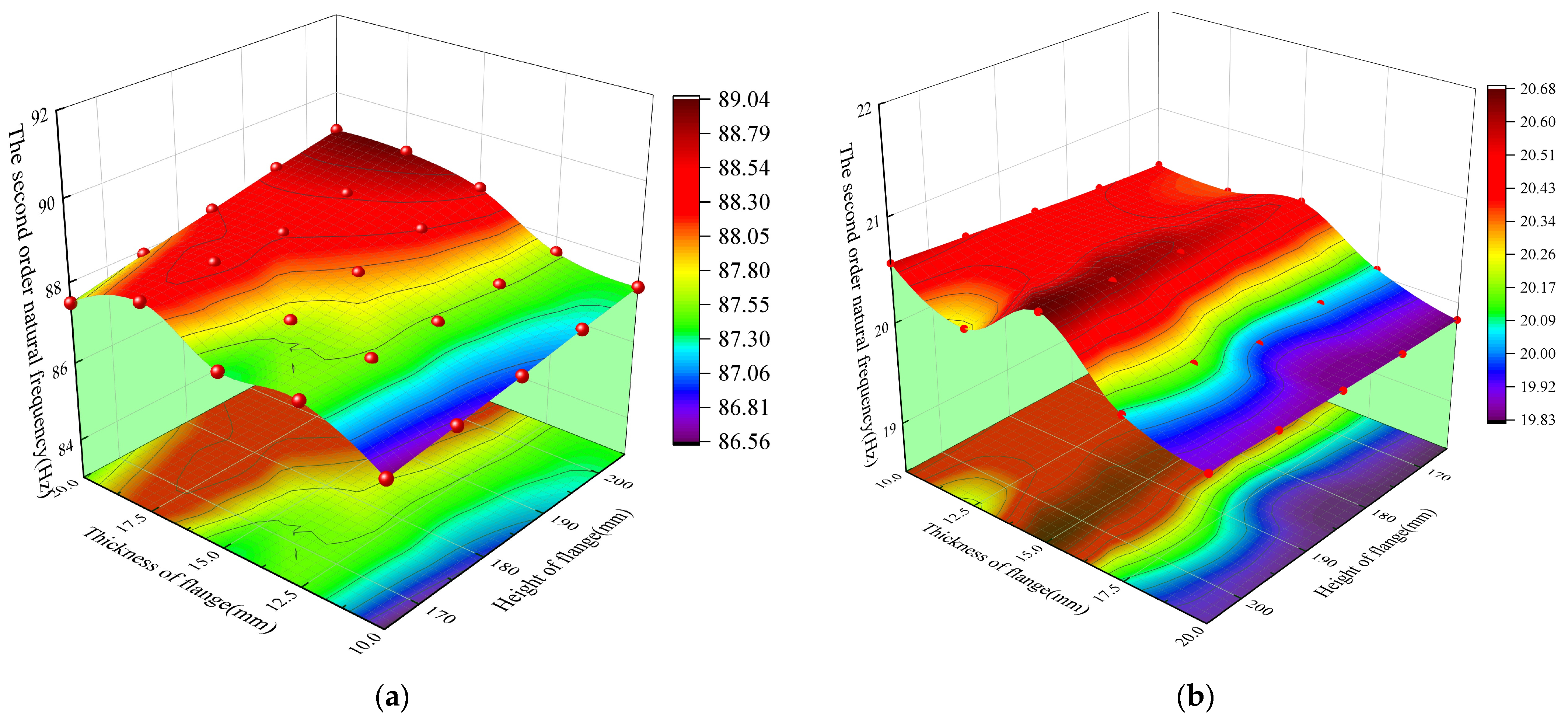

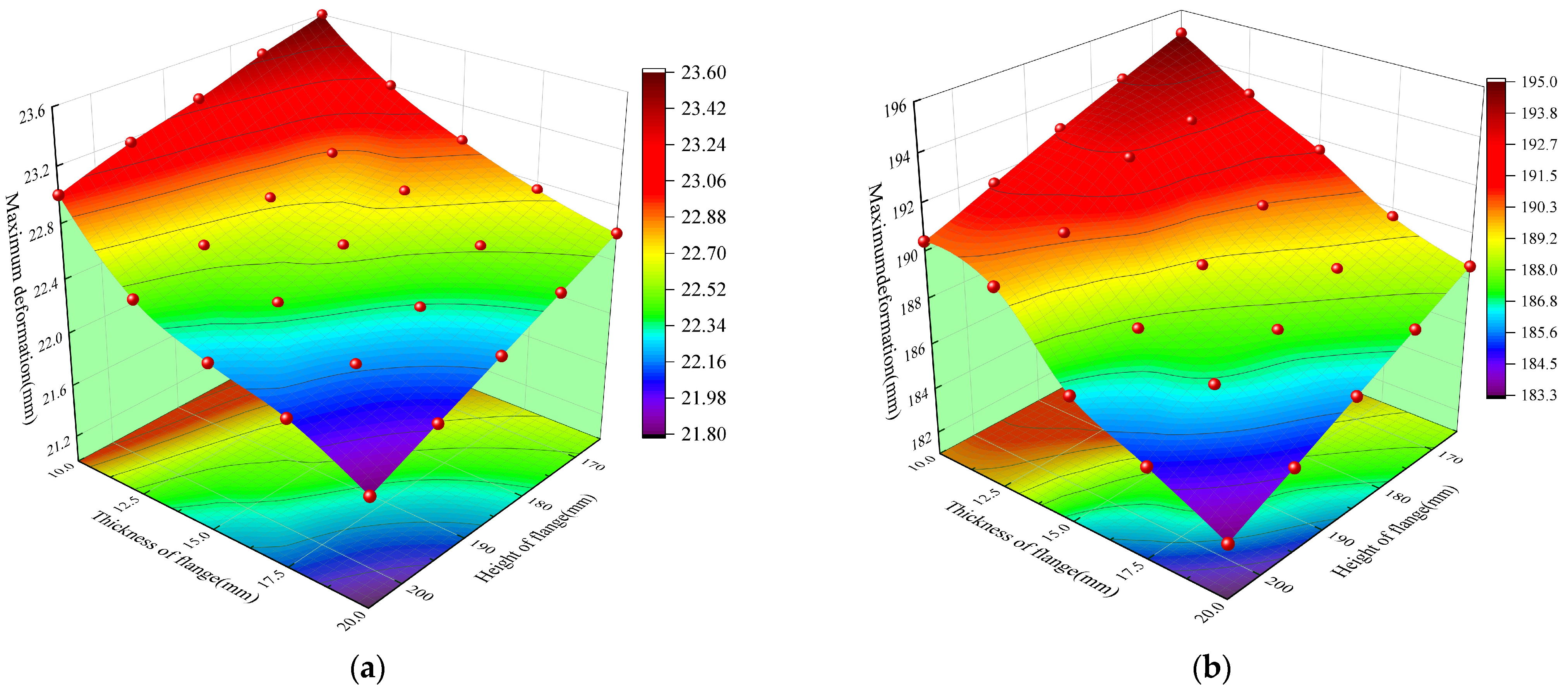
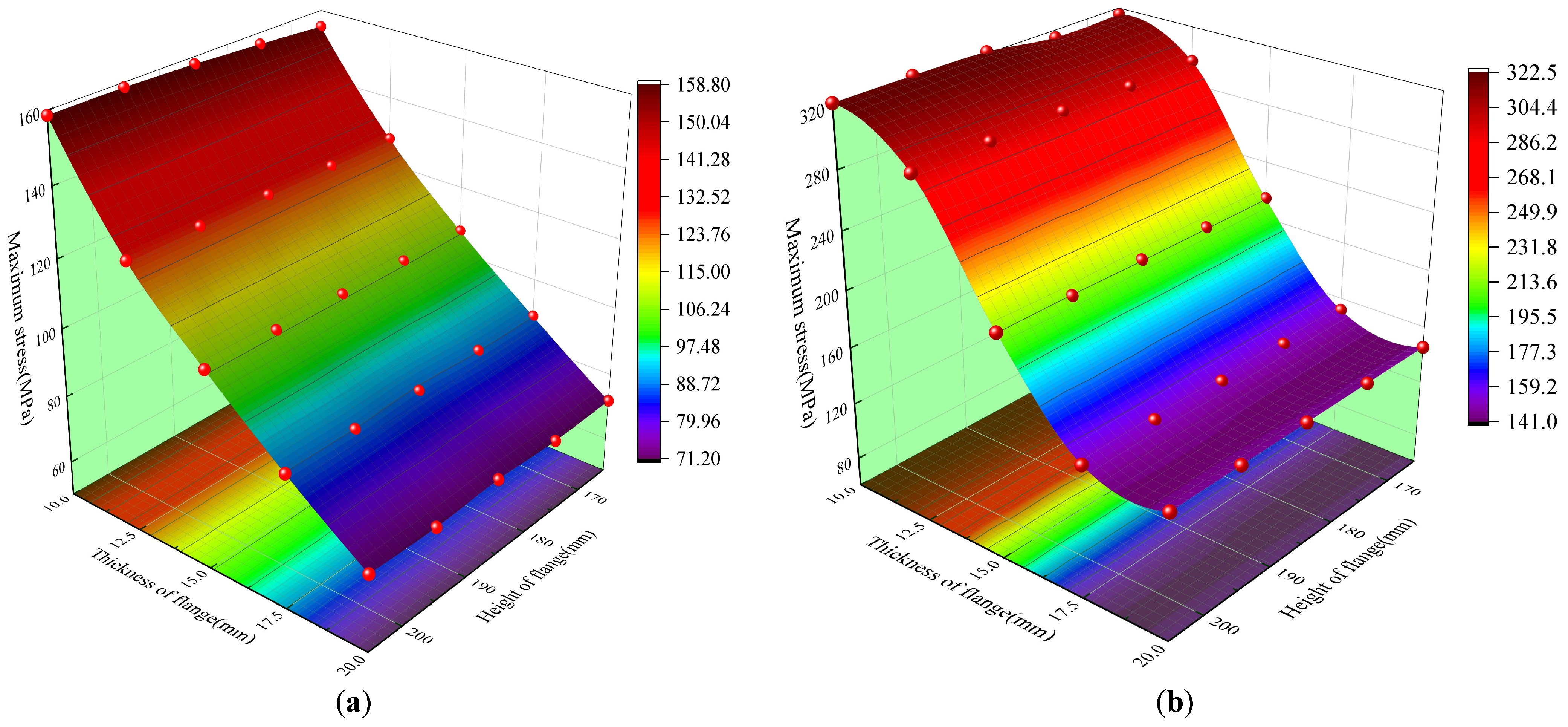
| Material | Elastic Modulus/GPa | Density/(kg·m−3) | Poisson Ratio |
|---|---|---|---|
| Mandrel | 45.5 | 2150 | 0.21 |
| Flange | 140 | 7850 | 0.30 |
| Model | The First-Order Natural Frequency/Hz | Second-Order Natural Frequency/Hz |
|---|---|---|
| Theoretical calculation of single insulator | 12.50 | 78.50 |
| Model of single insulator | 12.50 | 87.90 |
| Theoretical calculation of two insulators | 3.20 | 20.00 |
| Model of two insulators | 3.26 | 19.69 |
| Measure Point | Position | Direction | Channel |
|---|---|---|---|
| S2X-W | 1# insulator bottom west side X direction | 90° | 1 |
| S2X-E | 1# insulator bottom east side X direction | 90° | 2 |
| S3X-W | 2# insulator bottom west side X direction | 90° | 3 |
| S3X-E | 2# insulator bottom east side X direction | 90° | 4 |
| Force | guy rope | horizon | 5 |
| Loading Times | 1# Insulator | 2# Insulator | ||
|---|---|---|---|---|
| Elastic Modulus/GPa | Poisson’s Ratio | Elastic Modulus/GPa | Poisson’s Ratio | |
| 1 | 47.234 | 0.208 | 45.584 | 0.210 |
| 2 | 47.335 | 0.208 | 45.458 | 0.210 |
| 3 | 47.268 | 0.212 | 45.406 | 0.208 |
| 4 | 47.274 | 0.211 | 45.399 | 0.211 |
| average | 47.278 | 0.210 | 45.462 | 0.212 |
| Condition | Incoming Wave | Amplitude | Frequency Range Duration | Horizontal Direction |
|---|---|---|---|---|
| 1-X\Y | white noise | 0.1 g | 1–100 Hz 180 s | X\Y |
| 2-X\Y | 0.2 g | |||
| 3-X\Y | 0.3 g | |||
| 4-X\Y | 0.4 g |
| Condition | Incoming Wave | Amplitude | Frequency Range Duration | Horizontal Direction |
|---|---|---|---|---|
| 5-X\Y\Z | white noise | 0.1 g | 1–100 Hz 180 s | X\Y\Z |
| 6-X\Y\Z | 0.2 g |
| The First-Order Natural Frequency/Hz | Second-Order Natural Frequency/Hz | ||
|---|---|---|---|
| Single insulator | simulation | 12.50 | 87.90 |
| experiment | 12.20 | / | |
| deviation/% | 2.50 | / | |
| Two insulators in series | simulation | 3.26 | 19.69 |
| experiment | 3.23 | 19.30 | |
| deviation/% | 1.0 | 2.0 |
Disclaimer/Publisher’s Note: The statements, opinions and data contained in all publications are solely those of the individual author(s) and contributor(s) and not of MDPI and/or the editor(s). MDPI and/or the editor(s) disclaim responsibility for any injury to people or property resulting from any ideas, methods, instructions or products referred to in the content. |
© 2023 by the authors. Licensee MDPI, Basel, Switzerland. This article is an open access article distributed under the terms and conditions of the Creative Commons Attribution (CC BY) license (https://creativecommons.org/licenses/by/4.0/).
Share and Cite
Xiao, J.; Zhang, Y.; Xing, Y.; Jiao, Y.; Zhang, L. Mechanical Behavior of Crimping Composite Post Insulator: Experimental and Simulation Study. Buildings 2023, 13, 1275. https://doi.org/10.3390/buildings13051275
Xiao J, Zhang Y, Xing Y, Jiao Y, Zhang L. Mechanical Behavior of Crimping Composite Post Insulator: Experimental and Simulation Study. Buildings. 2023; 13(5):1275. https://doi.org/10.3390/buildings13051275
Chicago/Turabian StyleXiao, Jin, Yanhong Zhang, Yichuan Xing, Yangyang Jiao, and Lihong Zhang. 2023. "Mechanical Behavior of Crimping Composite Post Insulator: Experimental and Simulation Study" Buildings 13, no. 5: 1275. https://doi.org/10.3390/buildings13051275
APA StyleXiao, J., Zhang, Y., Xing, Y., Jiao, Y., & Zhang, L. (2023). Mechanical Behavior of Crimping Composite Post Insulator: Experimental and Simulation Study. Buildings, 13(5), 1275. https://doi.org/10.3390/buildings13051275






